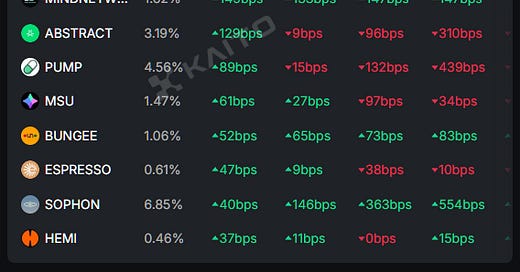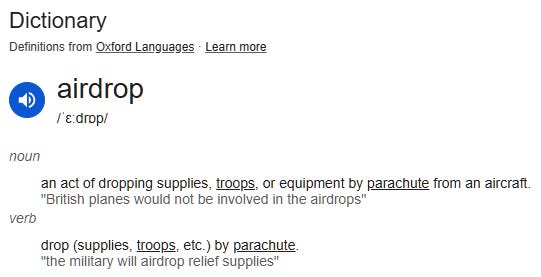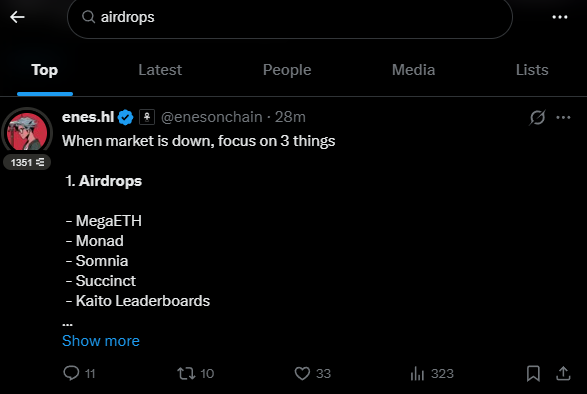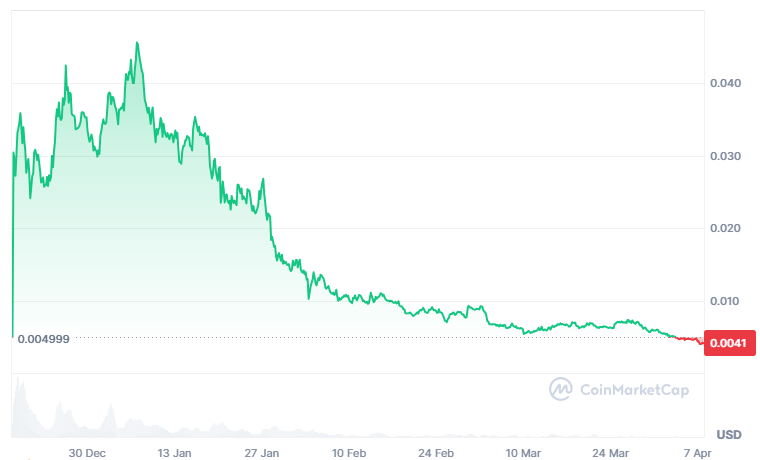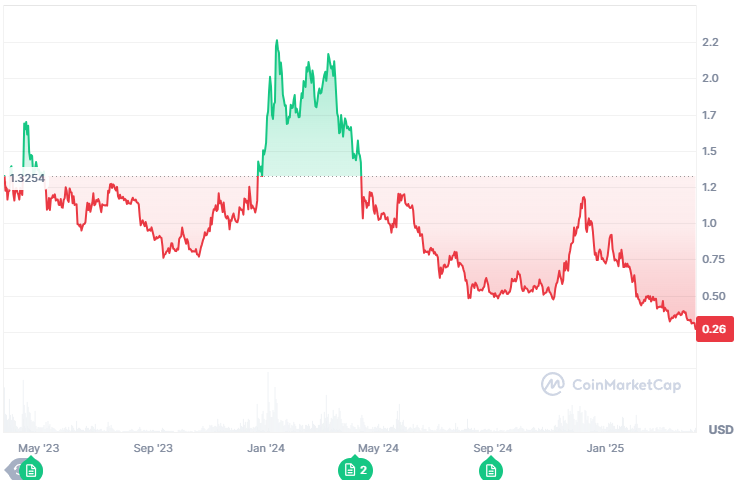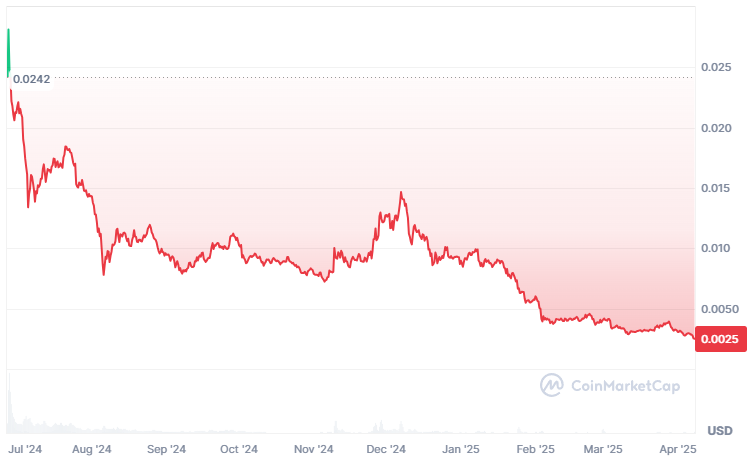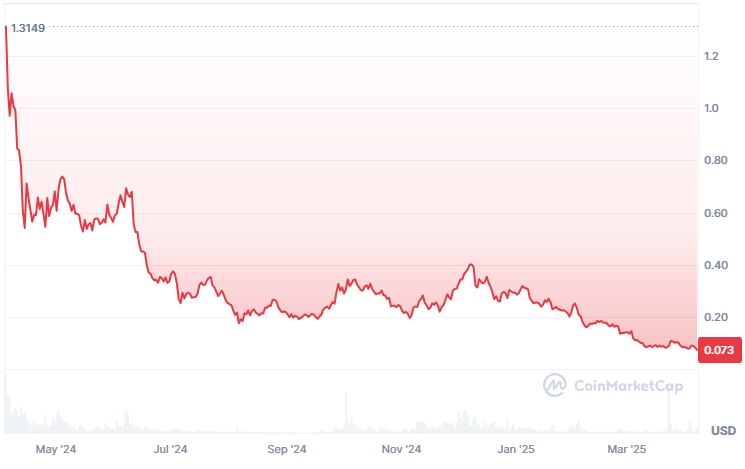Letter 58: The Ultimate Guide to Airdrops
Plus my list of 10 of the most profitable airdrops to be farming right now
The other day someone asked me if I could recommend a guide on airdrop farming. They wanted to know everything from the basics of what airdrops are, to the history of them and where they came from, and also how to go about finding and choosing which airdrops to focus on. So I said sure. I didn’t have one in mind, but surely there were already a million guides out there that I could find — this is such a popular topic after all.
So I googled. And searched Twitter. And googled some more. And I couldn’t find a single decent guide. They were all either too short, too spammy, too full of hyperbolic claims (do this and you WILL make $100k!!!!! eyeroll), too outdated, or straight up too poorly written.
So I said F it, I’ll write my own.
Now the next time someone asks someone for a guide on airdrops, maybe they’ll stumble upon this and think it’s worthy of sharing. Or maybe that someone will be you, and you’ll be able to send them this! Hooray for sharing valuable content (being very presumptious here, but I do hope you find this valuable 🙏).
Here’s what this guide will cover:
Why farm airdrops?
What even are airdrops?
A brief history of airdrops
What is airdrop farming?
What are the different types of airdrops?
So how do you actually farm an airdrop?
How do you find out about potential airdrops?
How do you decide which airdrops to farm?
How to stay organized
Hooray, you got an airdrop! Now what? Sell all? Sell some? Hold? Halp!
My list of 10 of the best airdrops to farm right now
I cover a lot here! Everything in this post is free and public up until the very end, where 2 of the 10 best airdrops are available for all to see, and the other 8 are gated for premium subscribers.
There’s currently a 20% sale on premium subscriptions in case you want to sign up.
Alright we have a lot to get to — so let’s jump right in.
Why farm airdrops?
The short answer: to make money. I’ve personally made around $1m just from airdrops since 2021. It would’ve been a lot more too if I did a better job of selling closer to each token’s respective top (which is an impossible task, so there’s no point wasting too much time dwelling on such things).
But yes, airdrops are an incredibly powerful way of making money in crypto. This is especially true for those who don’t have a lot of capital to begin with — you can literally start with $0 and earn your way to a significant bankroll by successfully farming the right airdrops.
I can’t say it any better than the absolute GOAT:
Who is GCR? Allow me to take a slight detour from airdrops to fill you in.
There are a grand total of two people in crypto who I hold in a higher regard than everyone else, purely because with the power of their words they have improved my way of thinking on many different occasions.
The first is Cobie, whose substack is phenomenal and I recommend everyone reads.
The other is GCR, whose track record of predicting events is nothing short of superhuman. Just to name a few: he called the top in 2021, foresaw the Terra Luna crash (famously shorting it for $20m), and predicted in 2022 that Trump would be on the 2024 election ballot, something that had very long odds at the time.
Beyond all of this, his tweets are full of wisdom. I recommend you go back and read through them all (yes it’s worth it), but for now, we simply highlight the one above.
There is no greater opportunity in this world than farming airdrops; can really change your life.
Airdrops are fantastic for those who are time-rich and capital-poor. It’s literally possible to start with $0. It’ll be time intensive and you won’t be able to catch a lot of the airdrops that require a bit of money to get involve, but you truly can still start from zero.
A few hundred to a few thousand dollars however can go a long way when it comes to airdrop farming — by using the funds to tinker around, try new protocols, chains, bridges, apps, etc.
Airdrop farming can also be great for those with a lot of capital to deploy. In many instances you can make your money work for you, earning yield in a DeFi protocol while simultaneously farming an airdrop. Win-win.
We’re getting a little ahead of ourselves though, especially for any newbies reading this. So let’s back up and answer the most basic question:
What even are airdrops?
Before we even get to crypto, the word “airdrop” had a definition:
I think it’s helpful to have this context when explaining what an airdrop is in crypto terms.
A crypto airdrop is basically a dropping of tokens (supplies) from a business or protocol (aircraft). The airdrop usually goes to users of the protocol, but occasionally to others as well. There are a few reasons a protocol might want to do this: to incentivize usage and adoption, to reward early users, to build goodwill, to grow a community, and/or to serve as a marketing tactic.
The tokens are given for “free”, in the sense that if you are eligible, you’ll literally just get tokens magically sent to your wallet.1 Sometimes these tokens are worthless or near worthless, but other times they can be worth enormous sums of money. It is not at all uncommon for people to receive hundreds, thousands, or even tens of thousands of dollars in a single airdrop (even more is entirely possible too).
A brief history of airdrops
The very first crypto airdrop happened all the way back in February 2014. It was called Auroracoin, and was intended to be an alternative currency to Iceland’s national currency (the króna). The tokens were given away to every citizen as the initial distribution for the coin, with the hope that this would generate awareness.
Auroracoin ultimately failed to gain any sort of significant traction, but it did set the stage for many (many, many, many) more people and teams to experiment with airdropping tokens.
The most famous airdrop and the one that most people remember as the first significant one was the UNI airdrop by Uniswap. To be honest, I actually thought this was the first ever crypto airdrop until I began writing and researching this piece. It’s that significant.
In September 2020, Uniswap sent out 400 UNI tokens to over 250,000 addresses, giving the tokens to anyone who had interacted with the platform prior to September 1st. At the time of the drop the tokens were worth around $2000 in total, but a few months later the airdrop ended up being worth about $20,000 per address for those who held. Absolutely insane.
Their reason they said they did this was not for marketing or awareness (everyone in crypto already knew who they were). Instead, it was to decentralize the protocol and create a DAO (decentralized autonomous organization), giving the users voting power to influence the governance of Uniswap.
One of the reasons the Uniswap airdrop was so successful is because it was unexpected. Nobody really thought of airdrops as a “thing”, and certainly nobody was trying to farm airdrops back then.
Ever since, though, “airdrop farming” has indeed become a thing, and the UNI drop has basically influenced every single airdrop moving forward.
What is airdrop farming?
Airdrop farming is basically doing anything with the explicit motivation of trying to receive airdrops. As an extension of the UNI drop (airdropping tokens to anyone who interacted with the protocol), the first iterations of airdrop farming were simply people using lots of protocols in the hopes of getting another similar drop.
Fast forward to today and it has become somewhat of an arms race — between the people farming airdrops vs the protocols wanting to airdrop tokens. The protocols generally want to send the tokens to genuine users, real human beings, and those who are likely to add value back to them in some way shape or form.
Farmers, on the other hand, are trying to maximize the quantity of tokens they get airdropped in order to make a profit, and are usually instantly selling the tokens they receive and offering little of value to the protocol once the airdrop has been completed.
People have now also come up with all sorts of sophisticated tooling, including bots, in order to create large amounts of wallets and do large amounts of transactions in an effort to simulate organic use. Protocols have likewise developed sophisticated tooling to weed out those trying to do this, and disqualify their wallets from receiving any tokens. Like I said, arms race.
You might hear people refer to “sybils” when discussing this. If you’re like I was when I first heard that term, you have no idea wtf people are talking about when they’re saying sybil-this and sybil-that. So here’s what it means and where it comes from:
Basically, when you sybil an airdrop, you are creating large amounts of wallets (identities) in an effort to gain a disproportionately large airdrop.
Protocols have many ways of combating this — one as mentioned above is to use software to analyze all potential wallets eligible for an airdrop and filter out the ones that look inorganic. But there are other options which I believe are better, and it all comes down to the type of airdrop chosen. There are many different approaches to airdrops, and we’ve only really scratched the surface.
What are the different types of airdrops?
Broadly speaking, all airdrops fall into one of three categories:
Retroactive & Unexpected Airdrops: These are dropped to users of a protocol based on some metrics that have never been announced (ie “transacted over $10k or made 20 transactions”) and often there was never any indication or confirmation that an airdrop would be happening. These tend to be the most profitable and successful airdrops as they are the toughest to farm. Some examples of retroactive airdrops are the UNI, ARB and OP airdrops.
Holder-Based Airdrops: These are dropped to holders of existing tokens, usually NFTs but occasionally fungible tokens too. You can’t farm these either, and these tend to be valuable airdrops. One key note however is that often the price of the underlying asset appreciates in the lead-up to the airdrop and then drops right afterwards, and the drop is roughly equal in value to what the airdrop was worth. Some examples of this are the APE and PUDGY airdrops.
Task-Based Expected Airdrops: These are airdrops where you become eligible by completing tasks. Sometimes it’s known in advance what tasks you need to complete, other times it’s a bit of guesswork. Examples of tasks include activity on testnets, governance voting, or social media tasks (like/comment/retweet type of stuff). These are often the least profitable airdrops, because these are also the ones that almost everyone farms.
Within each category there are sub-categories of types of airdrops too. I won’t go into detail about all of them, but here’s a list of most of the types so you get a high level picture: play-to-earn gaming airdrops, points based airdrops, referral airdrops, social airdrops, and staking-based airdrops — just to name a few.
For me personally, the most profitable airdrops, by far, have been the retroactive & unexpected airdrops. People will tell you that you can’t plan for these, and to them I say: bullhockey!2
You absolutely can plan for these and do things that make you more likely to be eligible for them. And the way to do it is refreshingly simple, and easy: be a curious and open-minded blockchain enthusiast and genuinely try lots of different things.
That’s it. The Uniswap airdrop was given to people who were around during the 2020 bear market and participating in DeFi. There was no expectation of an airdrop, they just got it.
The Arbitrum and Optimism airdrops were given to people who were trying things on each chain. Different rewards for different levels of activity, largely rewarding organic use and engagement over anything else. Optimism even did subsequent retroactive airdrops, rewarding those who actively participated in governance or continued to be active on the chain.
The ENS (Ethereum Name Service) airdrop came out of nowhere and rewarded those who had bought an ENS domain. All the .eth’s on Twitter were laughing that day. Today… not so much, but let’s not go there 🥲.
The Jito airdrop came for those who were using DeFi on Solana during the 2023 bear market. There have been a multitude of airdrops for those that have been active over on Farcaster.
These have all been some of the largest airdrops ever in terms of total amount dropped, but also in terms of value received per person. I didn’t get all of the above airdrops, but I did get ARB, OP, and ENS, and they along with some other retroactive airdrops have dwarfed the value I have received from all other ones — including ones I put enormous amounts of time and capital into farming.3
So how do you actually farm an airdrop?
This obviously varies from project to project, and your approach will depend on a variety of factors. First things first: you want to find out whether the project has explicitly mentioned there will be an airdrop, whether they’ve heavily hinted towards one, whether they’ve said nothing, or whether they’ve explicitly said there won’t be an airdrop.
If they’ve mentioned or heavily hinted at one, then on the one hand you know your efforts probably won’t be totally in vain; but on the other hand, everyone under the sun is going to be farming it.
Oftentimes when they are explicit like this, they’ll even lay down the exact steps required in order to be eligible. This makes it easy to know how to farm the airdrop — they’re literally telling you! It usually involves some combination of testnet activity + social media quests. Unfortunately, these are usually not worth farming. In reality, they are farming you.
Everyone always talks about airdrop farming from the perspective of the users, so it’s important to understand and remember: sometimes protocols also farm users!
They want users so they can increase their metrics. So they can brag about having 100,000 active wallets, about having over a billion dollars in TVL, about processing a million transactions a day, and so on. They are using you to test their network and to market for them on social media, and frequently won’t meaningfully reward you for your efforts.
I said that these are usually not worth farming. There are exceptions. One exception is that if you have literally $0 to begin with, these are often the best and only option you have. So if you do happen to be starting from zero, these can be a good way to get your start. Just don’t expect the moon from this type of airdrop campaign — if the team is making you jump through hoops and asking you to complete 20 tasks a week on galxe, keep your expectations low.
Another exception is if for whatever reason, a lot of people simply don’t bother completing the tasks required. This can happen due to laziness, or ignorance. Your advantage here is to stay educated, and to not be lazy.
If a project has said nothing or if they have explicitly stated they won’t do an airdrop, you’re now taking on a bit of a risk (time or capital) by trying to farm for one. It should be noted that there have been countless instances of a protocol saying they would never airdrop a token only to surprise everyone with a token some time in the future — this was likely done for regulatory reasons in the past; reasons which aren’t as relevant now. But they also sometimes say this to dissuage the sybils and bot farms.
These are generally the best airdrops to farm. Since there’s no guarantee of an airdrop, plenty of people won’t spend much time trying to farm these. If you do want to farm them, what’s the best method? My approach is what I mentioned above: be a curious and open-minded blockchain enthusiast and genuinely try lots of different things (you’ll notice this is a common theme throughout this guide).
If you want a little more direction on what this actually means, here’s a mental trick for how I think about it: work backwards. Reverse engineer the situation, and think about it from the protocols perspective.
What type of person and wallet addresss do they most want to airdrop tokens to?
They probably want to give tokens to long time and loyal users of the platform. Both as a reward, and because those users are less likely to instantly sell the tokens. Also if they’re trying to decentralize governance, then who better to give some voting power to than a long time and loyal user?
If they haven’t launched yet but have something running on a testnet, then they might want to reward with an airdrop those who have been genuinely testing their product, but not want to reward the bot farms spamming infinity transactions.
They probably also want to give tokens to those who are helping bring awareness to them on social media. Sidenote here, but one of the most valuable things you can do in this space is to build your personal brand and social media profile. It’s insanely profitable on so many levels, least of all that you sometimes randomly get airdrops just by existing and doing your normal thing (KAITO was an insane recent example).
At the end of the day, by and large, I would wager that most projects trying to do an airdrop are trying to get the tokens into the hands of real humans. Into the hands of those who have been genuinely using their product, and who they believe has a reasonable chance to continue using it moving forward. And, in an ideal world, to people who will not instantly sell 100% of their airdrop.
Last note on farming airdrops is to talk about most glorious carrot in all of crypto:
POINTS!
I think the points model started with Blur, where they gave out points to users of their NFT marketplace. Points for selling, points for listing, points points points. People went crazy for points, people still go crazy for points. Even outside of crypto — how many of you freaking love your credit card reward points, or your frequent flyer points? Humans love points!
Since points entered the crypto airdrop space, protocols have absolutely flocked to utilizing them. It’s brilliant: they can string people along for as long as they want, giving points (which costs them literally nothing), without even an explicit promise of tokens (degens will assume), and get real users and real volume on their platform.
All this to say — points can be great, they can also be a giant nothingburger. If you’re going to be farming points, it’s generally a good idea to do plenty of research so you understand the risk(s) you’re taking on and what you stand to gain. Is an airdrop guaranteed? What % of the overall token supply is being distributed to points-earners? Is it based on a per-point basis? What do you estimate the token’s FDV (fully diluted value) to be when the airdrop occurs? Etc etc etc.
Points based systems are often the best option for those with a lot of capital and not a lot of time. You can do things like stake money in a protocol and earn a few % yield on it, and earn a tonne of points, since the points usually scale linearly.
Anyway that’s a lot of talk on farming different types of airdrops — at the end of this article I share specifics on how to farm 10 promising upcoming drops — but let’s first answer the question of how do you even find airdrops in the first place (aside from subscribing to Letters from a Zeneca, of course).
How do you find out about potential airdrops?
This is actually the easy one! Ironically, it’s also the one that most people ask me about. “How do you find these things???”
Well, show and tell time.
Wanna know the big secret?
You go to twitter. Click on the search bar. Type in “airdrops” or “airdrop farming” or “best crypto airdrops” or some variation of these, and bingo bango bongo — you’ve found a bunch of tweets that are high value and contain a tonne of information about all sorts of upcoming airdrops. Many of these tweets will literally tell you step by step how to go about becoming eligible for them too.
It’s really that easy. You have to do a little bit of filtering through the irrelevant tweets that sometimes pop up, but it’s extremely easy to find lots of good information here. If you want to take it up a notch, you could use the advanced search function to filter by date so that you’re only finding the most recent tweets.
The same strategy works for Google too fwiw. Just by Googling you’ll find a tonne of guides with giant lists of airdrops, or “top 10 best airdrops to farm now!”
You’ll find the same on YouTube, and probably on TikTok and Instagram too (those are two of the social media devils that I have been able to hold at bay thus far, so I don’t know for sure).
For a slightly more “do your own research” approach, you can go here and sort in descending order by the “total money raised” and see what tokenless protocols there are which raised a bunch of money, since they all have the potential to one day launch a token.
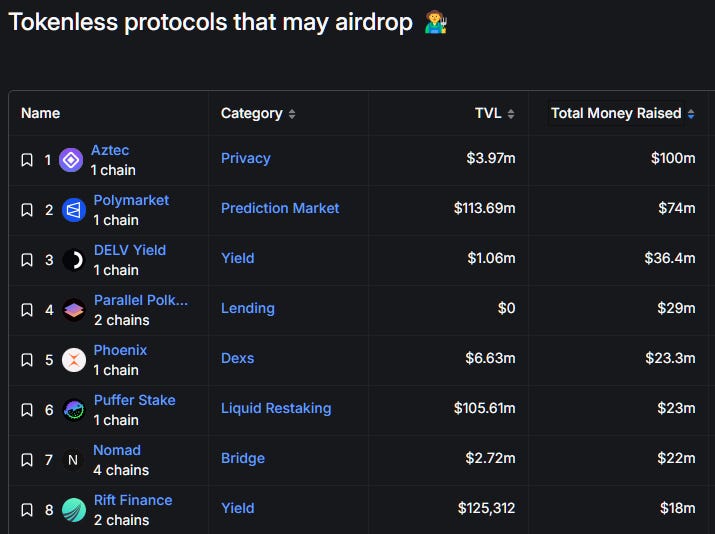
Another site that I find has a higher signal to noise ratio which lists upcoming airdrops is Kaito:

All this to say — it’s incredibly easy to find out about airdrops. This is not where you’re going to make the big bucks. The real skill is in discerning which potential airdrops are worthy of your time and attention.
How do you decide which airdrops to farm?
This is probably one of the toughest parts to all of this. At any given time, there are literally over 1000 protocols that you could reasonably expect to be planning an airdrop.
Fortunately the vast majority of them are junk and can pretty quickly get filtered out; but there is still at least several dozen legitimately interesting ones that you have to consider.
Okay so you’ve done a bit of research, you’ve found a bunch of tweets and threads where people are talking about upcoming potential airdrops, you’ve even found a couple on your own that others don’t yet seem to be talking about. But you have limited time and money, you can’t do everything and be everywhere, which ones to choose?
There’s no easy answer to this. It’s a bit of a game theory question. The better the opportunity, the more people are liable to be farming it, and the more people farming it, the less token-value per person. Since there’s no easy answer (sorry), the best I could think of for answering this is to provide a list of things that I take into consideration, so you could understand my thought process a bit beter.
There’s no one thing that makes me want to spend time and money on a potential airdrop farm — it’s always an aggregate of many things.
A reasonable place to start is by looking at the funding the team has raised. The more funding, the better, generally speaking. Over $10m is good, over $50m is great. One reason it’s good is that most investors are generally looking for a token to create some exit liquidity. Airdrop farmers are essentially taking a piggyback ride on some of the VC exit liquidity; it’s especially good since investor tokens typically have a cliff and vesting period and airdropped tokens typically don’t, so you can actually frontrun the VCs for once. Hooray!4
You can usually find how much funding has been raised pretty easily since almost all teams make a big splashy announcement when they close a funding round and it’s all over social media. You could also check the defillama site I mentioned earlier.
Another thing to consider — which is obvious but you’d be amazed how many people ignore this — is: is their product actually good? A very good question to ask yourself here is “would I use this if there were no incentives to use it?”
If the answer is yes, you might have yourself a winner. If no, that doesn’t immediately disqualify it, but it’s probably a sign that you don’t want to hold any future airdropped tokens very long.
You also want to look for any potential red flags — is there any evidence of the team going back on their word? Of not taking care of their community? Have they delayed, and delayed, and delayed their TGE (token generation event)?
If you really want to go deep, you can search the twitter history of the founder(s) or try and find interviews they’ve given to see if they’ve spoken on the topic of airdrops before — not even necessarily for this current project, but just their general thoughts can offer a lot of insight.
Airdrop farming is a bottomless rabbit hole; you can literally spend every waking hour researching and farming various airdrops if you really wanted to. If you have all the time in the world and nothing better to do, then maybe that’s great for you. For most people though, there’s an opportunity cost to airdrop farming. Consider what else you could be doing with the time and money, and pick your spots wisely.
If you are going to be actively farming multiple airdrops at once — above and beyond just being a curious and open-minded blockchain enthusiast trying things — I strongly encourage you stay organized. Use systems, keep good records, and track everything.
How to stay organized
Airdrop farming can be as simple or as complex as you want it to be. At the simple end of the spectrum, it is as I keep saying, all you have to do is be a curious and open-minded blockchain enthusiast and genuinely try lots of different things. This doesn’t require any sort of organization or meaningful tracking; you can just do things.
At the complex end of the spectrum you have literal bot farms that are managing tens of thousands of wallet addresses, automating transactions, spoofing IP addresses, and doing everything to try and game the system while going undetected.
Most people will (and should) fall somewhere closer to the simple end. Some will use several different wallets — either because they organically use several wallets (as I do) — or because they are trying to hit the airdrop a few times. It’s always a risky game to play because if they catch you intentionally trying to sybil, you can have your entire allocation disqualified.
The more airdrops you are farming at any given time, and the more wallets you are doing it on, the more important it is to have systems in place for tracking everything.
Organization is not my forte (hello ADHD), so this section will be do-as-I-say-not-as-I-do. My personal approach is utter chaos (I can’t even call it organized chaos), and not something I can in good conscience recommend.
I imagine a basic spreadsheet would suffice for most people and for most purposes. On it you can keep track of the different protocols you’re farming (and which wallets you’re using to farm them), what actions you’ve taken, and what actions you still need or want to take.
Sometimes you will want to regularly repeat actions (ie make a swap every day on a protocol, or use a bridge once a week). A simple recurring calendar reminder can work for this, or a to-do app, or whatever works for you really. But I wouldn’t recommend relying on your memory if you’re trying to do a lot of this.
I think it is prudent to keep track of the airdrops you receive and then also what you end up doing with them — if and when you sell, and how much you sell for. This is helpful for a bunch of reasons: firstly you can review your history and see whether you’re making good decisions or not (on average are you holding too long? are you selling too soon? etc); and secondly, importantly yet unsexily: it’s very helpful for tax purposes.
Tax is a monstrous topic that is largely outside the scope of this post, mostly because how airdrops are treated tax-wise differs country to country. In America I believe they consider it a capital gain the moment you receive the tokens in your wallet, based on their fair market value at the time of receiving them. In Australia, if it is the first time you’re receiving the tokens, it is treated as something with a cost-basis of $0 (so if/when you sell, the entire amount is considered a capital gain). Subsequent airdrops are treated as ordinary income.
I think. Maybe. I’m no tax expert; and the above is certainly not tax advice. I strongly recommend you seek your own tax advice (unless you’re fortunate enough to reside in a tax haven). Someone who helps me with my tax and who I cannot recommend highly enough is CryptoTaxSucks via his company CryptoTaxMadeEasy. Not sponsored, no kickbacks; just a fan.
Alright so you’ve found and farmed your favourite airdrops — how do you avoid fumbling the bag?
Hooray, you got an airdrop! Now what? Sell all? Sell some? Hold? Halp!
Figuring out what to do with your airdropped tokens is a dilemma that has kept many a person awake at night. My best advice is to come up with a plan before you receive any tokens, including having a plan for situations where you get one of those wonderful out-of-the-blue surprise airdrops. And not to beat a dead horse, but your plan should consider your tax liabilities.
It is a fools errand to try and time the top, yet so many people try, and to make matters worse, they then lambaste themselves when they get it wrong.
You’re always going to get it wrong!!
Maybe once in a very blue moon you will get extremely lucky and sell the generational top, but failing that, the best you can hope for is to get sorta-kinda-close.
Assuming you are attempting to make money, your plan should, obviously, include selling some or all of your tokens. Some people fall in love with certain protocols, become bulls and advocates, get involved with governance, and keep all their tokens, maybe even buying more. If that happens to you, great, more power to you — godspeed and good luck. If you find it happening to you on any sort of regular basis though, then you’re probably getting too attached too easily.
I generally believe people should hold fewer positions, and accumulating airdrops is one way to quickly inflate the number of positions you have to manage — another reason for selling (and for selling the entirety of your position).
Alright I took the liberty of pulling up the charts of a whole host of airdrops because I think it’s enlightening to look at how they’ve performed over time. Past results are no guarantee of future results, I know that, but also… history rhymes.
I think there’s a lot to learn here.
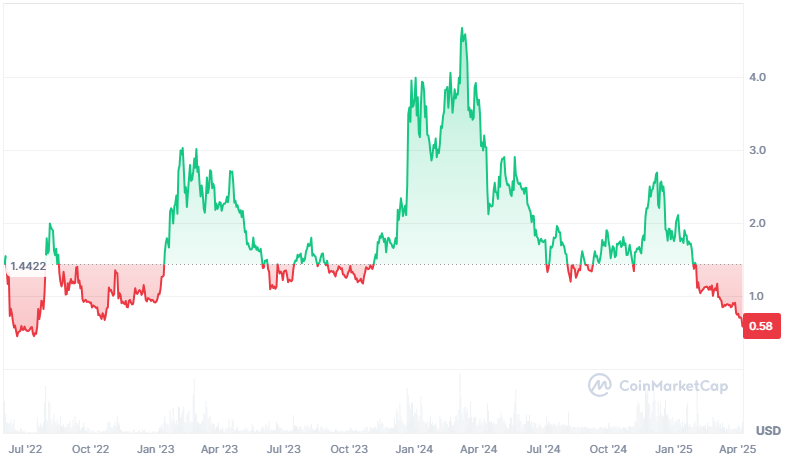
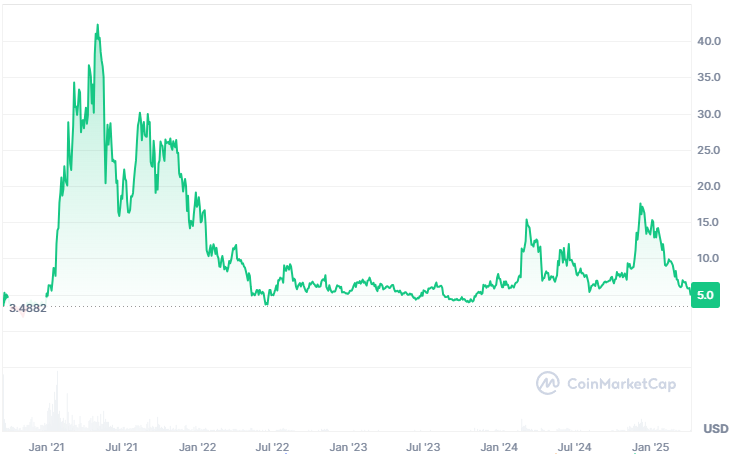
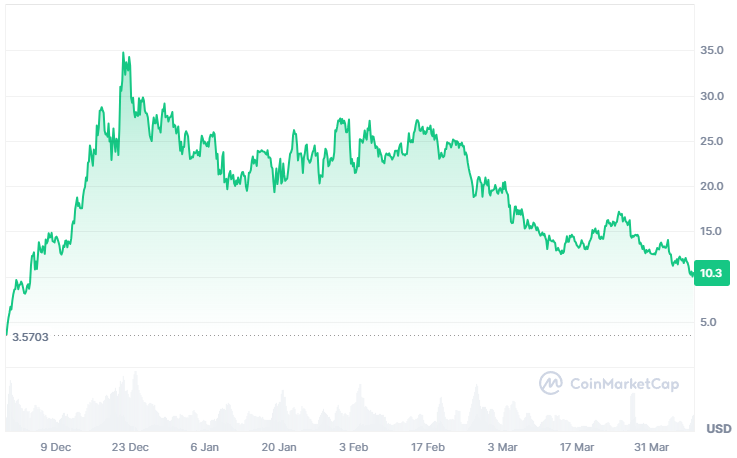
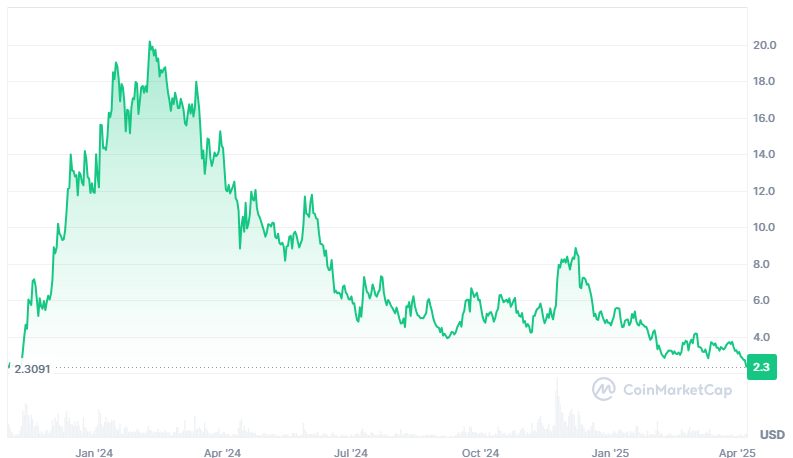
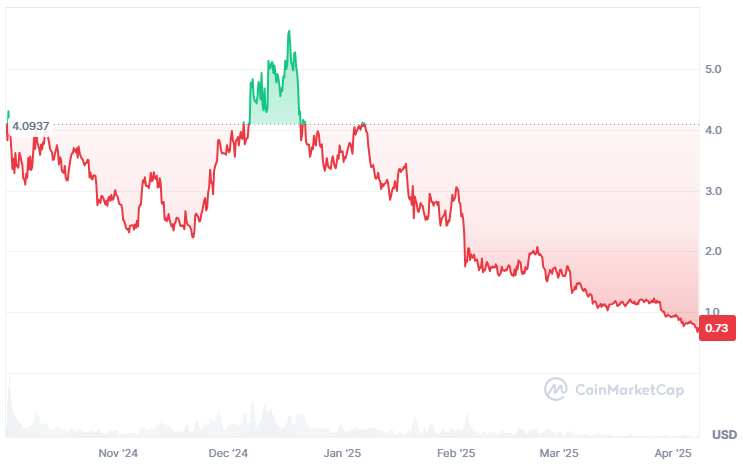
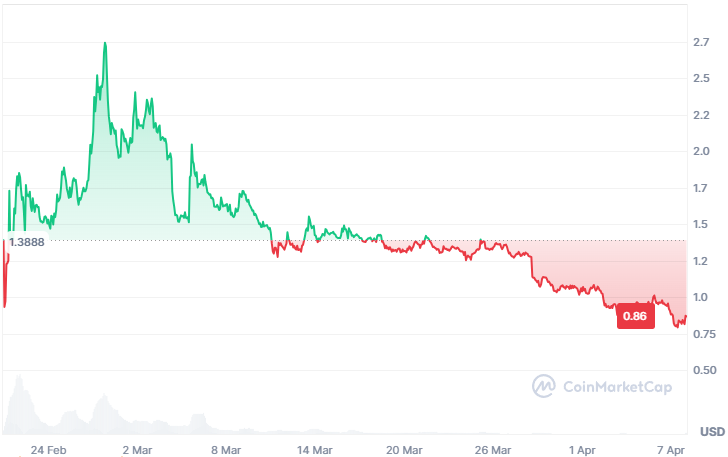
That’s only a small snapshot of all crypto airdrops, but I believe it’s a fairly representative sample. I hope you can see the same thing I can: you should basically always within the first few weeks of the airdrop. Sometimes immediately selling was best, sometimes the top came a little while later — but it almost always came relatively early on in the lifecycle of the token.
This actually presents a bit of a problem for the teams that are doing the airdropping since obviously they don’t want people to be instantly selling every token they receive. That isn’t building community, it isn’t (really) decentralizing things, and while it might receive some attention for marketing purposes, it’s unlikely to be positive attention. And contrary to popular belief, all publicity is not good publicity.
The best possible publicity in crypto is number go up. The technology is always so much better when the price is going up! It is revolutionary, a new paradigm, unlike anything we’ve ever seen before! Best team ever, best community ever!
Nobody can compete with a team that has number going up.
Likewise, if number is going down, a hole is being dug that gets more and more difficult to crawl out of the lower number goes.
How can teams incentivize holding? And how can you try and identify the exceptions to the rule, the HYPEs and the UNIs of the airdrop world?
To me it all comes down to a single word, and it’s not always a popular word inside of crypto and it’s certainly not a popular word outside of our crazy world.
The word: cult.
If you’re a team, you want to grow a cult like following. You want to build a product so good that people love to use it. You want to treat your users so well that they want to tell their friends and scream your praises from the rooftops. You want to foster a community that is so passionate that when they notice something wrong, they quietly bring it to your attention so you can fix it rather than putting you on blast on social media.
If you’re an airdrop recipient, you want to try and identify whether a cult is forming around you. If so, perhaps, maybe, potentially, hold your tokens. You need to be pretty damn sure that the stars are lining up though, since, well, I’ll refer you back to the charts above. Things generally don’t go so well when you hold. But when they do go well, they can go very well, see: Hyperliquid.
Phew! If you made it this far, congratulations, thank you, and my apologies. I would have written a shorter missive but I didn’t have the time, etc etc etc.
Now on to a list of 10 current airdrops I am farming myself.
I actually had more, but this is a ridiculously, stupefyingly, and stupidly long post already — so as a bonus to whatever I write next week, I will include some write-ups on more of my favourite potential airdrops in next week’s newsletter.
My list of 10 of the best airdrops to farm right now
This list is in no way exhaustive. As I mentioned earlier, there are a ridiculous amount of potential airdrops out there. Basically nobody can be on top of them all, and you have to pick and choose. These are some of the ones I have chosen. I admit that I might be missing some big ones, and I accept that. I do believe that, on the balance, all of these will yield significant profit for those that put in the time (and in some cases capital) to get involved.
Without further ado..
1. Wayfinder (**TIME SENSITIVE**)
This is pretty much the most hyped airdrop at the moment. It’s also time sensitive — the airdrop is likely happening within the next week, and so I encourage you to take a few minutes to get some exposure sooner rather than later.
What is Wayfinder? In their own words: Wayfinder is an omni-chain tool providing groundbreaking ways for AI to interact with blockchain environments. Read the whitepaper here for full context. The tldr version is that Wayfinder is an AI DeFi product that makes it easy for users to do complex blockchain tasks using a chatgpt like interface.
The team behind this is extremely savvy, have shipped several good products already, AI is the most significant narrative in the world right now, and the intersection of AI and Crypto is what excites me the most in the space. So Wayfinder really has it all for me.
They made this one easy to get exposure to and have basically said that they are allocating 0.5% of the total supply of tokens to anyone who signs up to wayfinder and completes the missions. This takes a total of like 5-10 minutes and is absolutely worth it.
Go through the “wallet missions” (basically fund your wallet with $10 on a bunch of different blockchains). If you need to bridge from one chain to another, I recommend Relay.
Go through the “community missions” (all fairly self explanatory)
That’s it.
I’m not necessarily expecting the moon here because, like I said earlier in my post, airdrops that explicitly state the requirements which include missions + social media quests usually aren’t the greatest.
But I do think this is basically going to be free money, even if it isn’t a lot. And who knows, maybe we end up surprised and it’s hundreds or even thousands per user (I don’t want to set expectations too high though, especially in these market conditions; in general it’s best to have low expectations and be pleasantly surprised with anything extra rather than expecting the world).
2. Nansen
Nansen is an onchain analytics platform — I want to say it’s the OG onchain analytics platform? It has been around for years and has been killing it for years. They have an extremely successful product and are a revenue generating protocol via the monthly subscriptions for access to their analytics.
I’m not sure if they’ve 100% confirmed an airdrop, but if they haven’t, they’ve all-but confirmed it. Their CEO Alex Svanevik is regularly talking about “nansen points” and in crypto land we all know that points is basically code for future airdrop.
The way to get exposure here is by staking crypto assets on their platform — my guess is that points will scale based on the total value you stake multiplied by the duration you stake for, making this one of the better opportunities for those who are capital-rich and time-poor.
I think this one is somehow still pretty under the radar, probably because the points aren’t shown anywhere on the website yet.
They’ll be retroactively applied when it launches:

